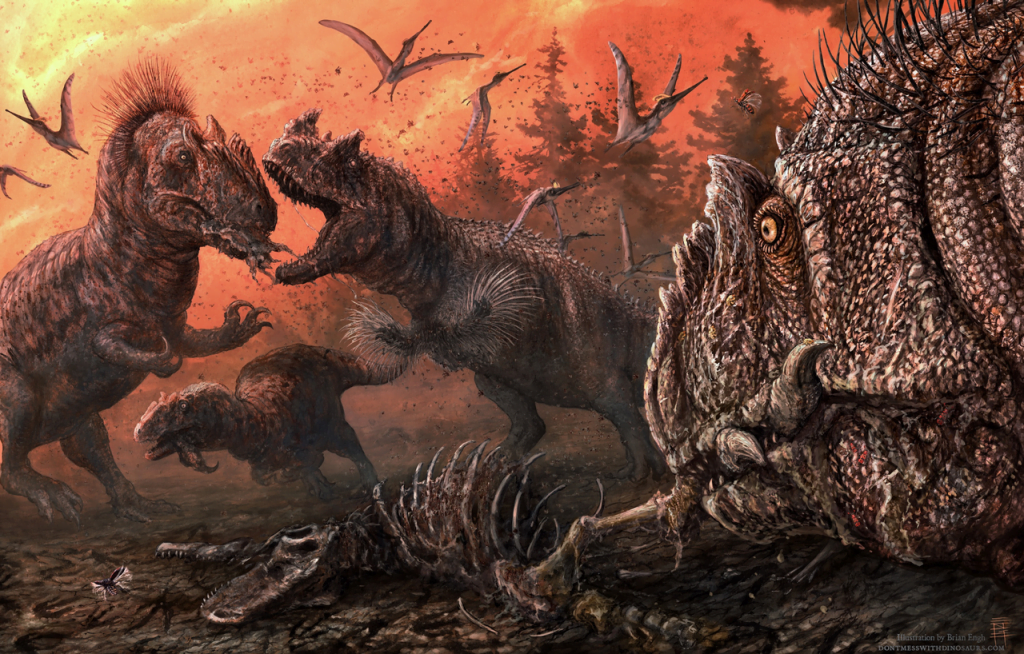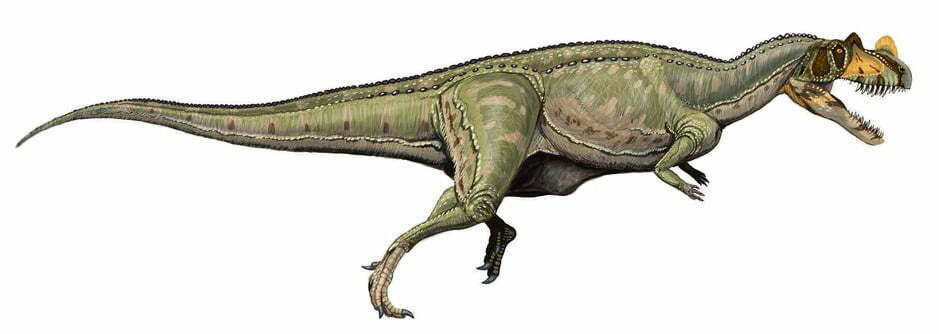Dinosaur, Ceratosaurus, the Crimson Stalker
You won’t believe how Ceratosaurus prowls riverbanks with its razor-sharp horn and scythe-like teeth to shred prey in seconds!

Ceratosaurus is a lean, muscular theropod reaching up to 20 feet in length, with a distinct blade-like skull crowned by a prominent nasal horn and twin brow ridges. Its hide is scaly and irregularly mottled—typically in earthy reds, greys, and ochres—offering camouflage in dappled light and muddy terrain. Rows of small bony osteoderms trail down its back, culminating in a long, flexible tail used for balance and intimidation. Its jaws are lined with long, recurved teeth perfectly suited to slashing rather than crushing.
Behaviour
Ceratosaurus is a cunning, opportunistic hunter. It prefers to stalk rather than charge, using patience and stealth despite its size. Highly territorial, it marks its domain with gouges in trees and scatters of picked-over bones. It rarely roars—preferring low hisses and guttural clicks to communicate dominance or intent. Though solitary, it will tolerate another of its kind during mating season or when food is plentiful.
Habitat
This predator favors dense riparian forests, riverbanks, floodplains, and lake margins. It thrives in transitional environments where prey gather near water and terrain allows for concealment. Fallen logs, reeds, and murky shallows are natural blinds from which it launches ambushes.
Modus Operandi
Ceratosaurus hunts with a combination of stealth and sudden aggression. It silently stalks prey from cover, often wading silently through water or dense brush. When within range, it strikes with an explosive leap or rush, aiming to knock its victim prone and deliver a flurry of slashing bites. Its horn isn’t just ornamental—it uses it to gore fleeing prey or dislodge competitors in brutal shoving matches. Once prey is downed, it drags the body to cover to feed in safety.
Motivation
Ceratosaurus hunts to survive and defend its domain. It has no interest in prolonged battles and avoids unnecessary risk. However, it will attack intruders or challengers to assert dominance, and will ferociously defend a fresh kill or nesting site. Its drive is simple but relentless: feed, dominate, endure.
Ceratosaurus 5e
Ceratosaurus, Pathfinder
Ceratosaurus
Large Beast (Predator), Unaligned
CR 6 (2,300 XP) • Proficiency Bonus +3
Armor Class 14 (Natural Armor)
Hit Points 110 (13d10 + 39)
Speed 40 ft., swim 20 ft.
| STR | DEX | CON | INT | WIS | CHA |
|---|---|---|---|---|---|
| 20 (+5) | 14 (+2) | 17 (+3) | 2 (–4) | 14 (+2) | 8 (–1) |
Saving Throws
Dex +5, Con +6, Wis +5
Skills
Perception +5, Stealth +5
Senses
Darkvision 60 ft., Passive Perception 15
Languages
—
Traits
- Hold Breath. The Ceratosaurus can hold its breath for up to 10 minutes.
- Keen Smell. The Ceratosaurus has advantage on Wisdom (Perception) checks that rely on smell.
- Display Threat. As a bonus action, the Ceratosaurus can flare its nasal and brow ridges, letting out a sharp hiss. Each creature within 30 feet that can see and hear it must succeed on a DC 13 Wisdom saving throw or have disadvantage on the next attack roll made against the Ceratosaurus before the end of its next turn.
Actions
Multiattack
The Ceratosaurus makes two Bite attacks.
Bite
Weapon Attack: +8 to hit, reach 5 ft., one target
Hit: 21 (3d10 + 5) slashing damage. If the target is a creature, it must succeed on a DC 15 Constitution saving throw or begin bleeding, taking 5 (1d10) damage at the start of each of its turns. A creature can end this effect with a DC 12 Wisdom (Medicine) check or any magical healing.
Tail Sweep (Recharge 5–6)
The Ceratosaurus spins and lashes its tail in a wide arc. Each creature in a 10-foot cone behind it must make a DC 15 Dexterity saving throw.
- On a failed save: Take 14 (4d6) bludgeoning damage and be knocked prone.
- On a success: Take half damage and remain standing.
Territorial Roar (1/day)
The Ceratosaurus unleashes a deep, resonant roar. All creatures of its choice within 60 feet that can hear it must succeed on a DC 15 Wisdom saving throw or be frightened for 1 minute. A frightened creature can repeat the saving throw at the end of each of its turns, ending the effect on a success.
Tactics
- Uses stealth and terrain to ambush prey with a powerful bite.
- Employs Display Threat to deter attackers or interrupt enemy focus.
- Uses Tail Sweep to break up clusters or escape if surrounded.
- Opens with Territorial Roar when threatened by a group.
Environment
Tropical jungles, riverbanks, and floodplains.
Treasure
None, though the horn and teeth may fetch 25–100 gp to collectors or scholars.
Bladelike horns jut from the snout and eye ridges of this toothy, bipedal dinosaur.
Although a ceratosaurus’s horn is mainly for courtship displays, its jaws are extremely deadly. A ceratosaurus stands 10 feet high and can grow up to 18 feet long and 1,600 pounds.

Ceratosaurus CR 5
XP 1,600
N Large animal
Init +6; Senses low-light vision, scent; Perception +7
DEFENSE
AC 18, touch 11, flat-footed 16 (+2 Dex, +7 natural, –1 size)
hp 52 (8d8+16)
Fort +8, Ref +8, Will +4
Defensive Abilities ferocity
OFFENSE
Speed 40 ft.
Melee bite +12 (2d6+10 plus trip)
Space 10 ft.; Reach 10 ft.
Special Attacks blood rage
STATISTICS
Str 24, Dex 15, Con 15, Int 2, Wis 11, Cha 10
Base Atk +6; CMB +14; CMD 26
Feats Improved Initiative, Iron Will, Run, Skill Focus (Stealth)
Skills Perception +7, Stealth +12; Racial Modifiers +4 Stealth
SPECIAL ABILITIES
Blood Rage (Ex)
When a ceratosaurus takes damage in combat, on its next turn it can fly into a rage as a free action. It gains +2 Constitution and +2 Strength, but takes a –2 penalty to its AC. The rage lasts as long as the battle or 1 minute, whichever is shorter. It cannot end its rage voluntarily.
ECOLOGY
Environment temperate or warm forests or plains
Organization solitary, pair, or pack (3–7)
Treasure none
Section 15: Copyright Notice
Pathfinder Roleplaying Game Bestiary 5 © 2015, Paizo Inc.; Authors: Dennis Baker, Jesse Benner, John Bennett, Logan Bonner, Creighton Broadhurst, Robert Brookes, Benjamin Bruck, Jason Bulmahn, Adam Daigle, Thurston Hillman, Eric Hindley, Joe Homes, James Jacobs, Amanda Hamon Kunz, Ben McFarland, Jason Nelson, Thom Phillips, Stephen Radney-MacFarland, Alistair Rigg, Alex Riggs, David N. Ross, Wes Schneider, David Schwartz, Mark Seifter, Mike Shel, James L. Sutter, and Linda Zayas-Palmer.

 Buy me a coffee
Buy me a coffee